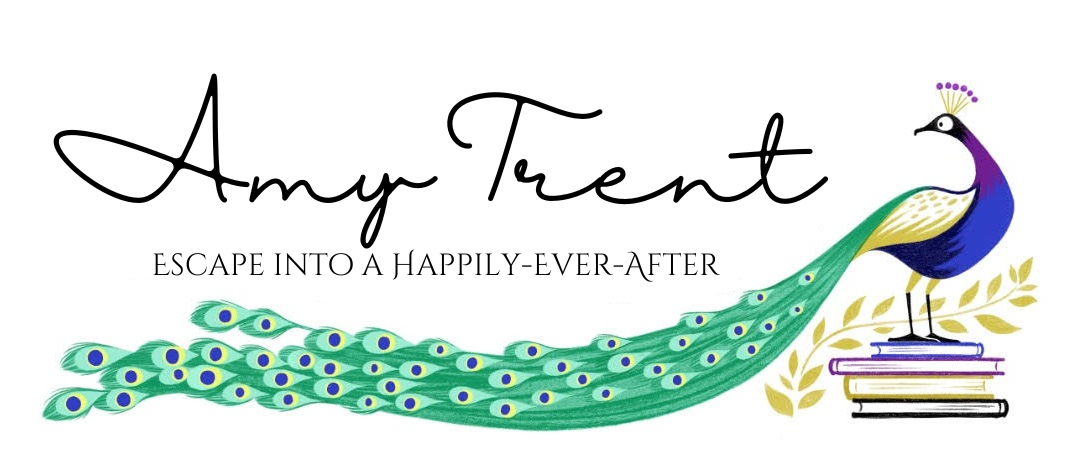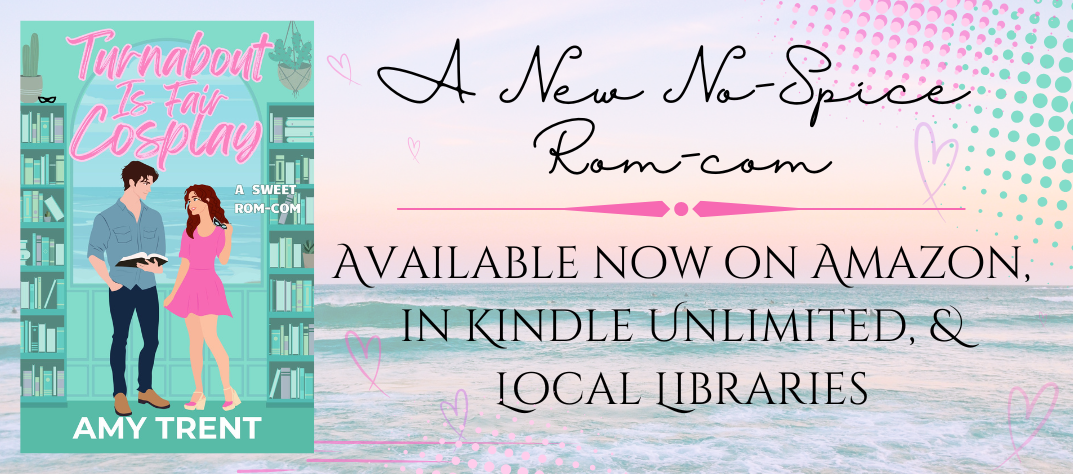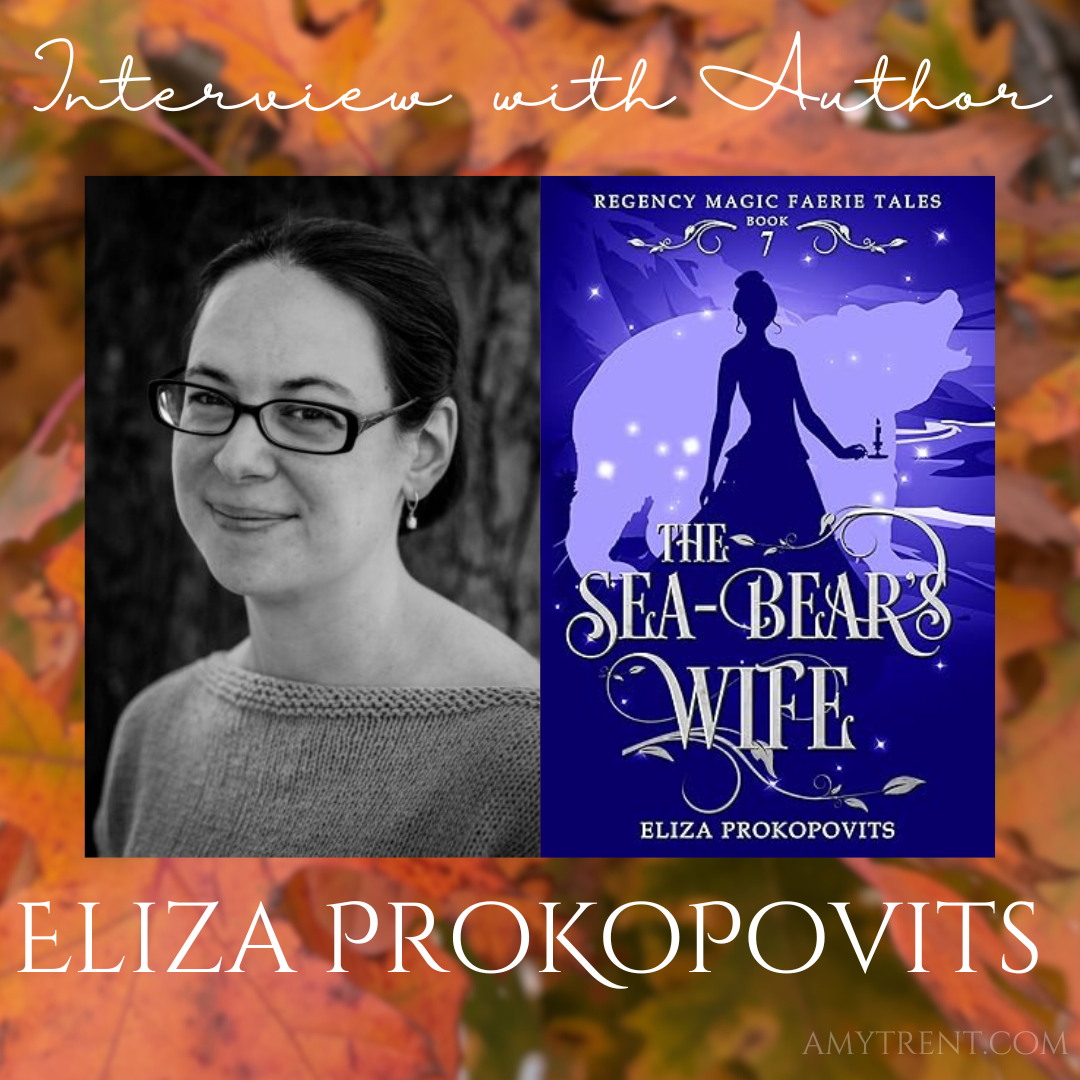Amy: Welcome, Eliza! Thanks for joining me today! I’m excited to talk fairy tales and talk about your new book, The Sea-Bear’s Wife. This is the seventh book in your Regency Magic Faerie Tales series and a retelling of “East of the Sun West of the Moon.” So let’s start here. Why regency and why historical fiction for your fairy tale retellings?
Eliza: It all started with reading. I love Patricia C. Wrede’s books, and I adore how she mixes magic with Regency in Sorcery and Cecelia and Mairelon the Magician. I’d finished rereading them for the who-knows-what-th time, and I decided I wanted my own magical Regency London, and I wanted to retell fairytales there. The first fairytale that seemed to make the most sense with the London social Season was The Twelve Dancing Princesses, and that’s how Her Fae Secret was born. I loved it too much not to come back again and again as new fairytales presented themselves.

Amy: “East of the Sun West of the Moon” isn’t exactly a widely well-known fairy tale. There aren’t any popular(cough, Disney, cough) film adaptations of this Norwegian fairy tale. I just double checked my childhood anthologies, and this one wasn’t in either of them. When did you first come across this fairy tale, and what was it about the folklore that made you excited to turn it into a novel?
Eliza: I think I read it for the first time in The Blue Fairy Book by Andrew Lang, and then I was hooked, so I looked up the original version. There’s something really powerful about looking at the forbidden. Pandora’s Box, Lot’s wife in the story of Sodom and Gomorrah, Bluebeard’s wife–they’re all forbidden to look, and they all fail. So that grabbed my attention. But more importantly, I love the fact that the story doesn’t stop there. She realizes that she messed up by looking, and she goes to great lengths to fix it, to make things right and to get her husband back. There’s determination, grit, cleverness, and also a strong sense of faithfulness and an unwillingness to give up. I love that.

Amy: Okay, I don’t think this is a spoiler because it’s in the title and the back cover copy, but The Sea-Bear’s Wife is a marriage of convenience romance AND it is a no-spice young adult book. I’m not sure if I’ve ever seen those two combined, but it really works in your novel. How did you come to pair this fairy tale with this trope for this audience? What do you love about marriage of convenience stories? What did you want to make sure to avoid?
Eliza: To be honest, “East of the Sun, West of the Moon” was one of the very first fairytales I wanted to retell, but I couldn’t think of a way to make it work for a YA audience. I write clean YA books that align with my Christian values, which meant that I wasn’t comfortable with the idea of unmarried characters sharing a bed. So I put the fairytale on the back burner for years. In the meantime, I started reading more romance books and discovered the marriage of convenience trope. I love how characters in these books start out as acquaintances, friends, or even enemies, with no intention of falling in love, and yet their marriages become real, honest-to-goodness, true-love marriages by the end. It’s kind of a backward romance–marriage first, falling in love after. It wasn’t until after becoming more familiar with the marriage of convenience trope that I realized it was the solution to my “East of the Sun” dilemma–the characters could share a bed if they were married, while keeping it no spice.
Amy: There are some really fun descriptions in this story of a quilt that your heroine, Nora, makes that made me wonder if you are a quilter and what cozy pastimes you enjoy when you’re not writing, but I wanted to ask you about the coziness of this series and especially in this book. Nora goes on epic adventures a few times in this story, but she also devotes herself to quieter, cozy pursuits that (without spoilers) are key to her HEA. What fascinates you about pairing coziness with fantastical elements?
Eliza: I am naturally a mix of both myself. I love traveling (I used to do a lot more of it before having kids), but I’m also a total homebody. My primary craft hobby is knitting, but I also spin yarn and crochet, and I occasionally enjoy baking. I have also quilted, cross stitched, and made jewelry in the past. So mixing fantasy with cozy vibes feels comfortable to me. I also want my books to feel like a warm hug, an escape when daily life feels like a little too much.

Amy: Nora has the strength to ask for help, and as a result finds help repeatedly. Lady Agnew was my a standout example. Why do you think it is so hard to ask for help, and why was this a message you wanted your YA readers to embrace?
Eliza: It is hard to ask for help, and it’s hard for me to ask for help, sometimes because I want to feel independent and capable and sometimes because I don’t want to put someone else to any trouble. But sometimes it’s necessary. Sometimes there is something more important than my resistance. I think that’s what it is for Nora–finding Alek is more important than any independence or reluctance she may be feeling. The original fairytale includes the FMC receiving help along the way, which is yet another reason I love it. Giving and receiving help is a way of connecting with other people and building relationships, and I think that’s so important and so undervalued in our current culture.

Amy: I want to come back to what you were saying earlier about how there’s something really powerful about looking at the forbidden. And I love the examples you referenced. Do you think there might be something a little subversive going on with this motif too? There are some really powerful moments in _The Sea-Bear’s Wife_ when Nora realizes that she was set up to fail. It reminded me of the Taylor Swift lyric, “You play stupid games, you win stupid prizes.” Is this a lesson you had to learn as a young adult? I don’t want to give away any spoilers, but did you, like Nora, need to reframe how you approached stupid games?
Eliza: I can’t think of a time when I was specifically set up to fail in the same way Nora was, but in college I did feel like I was playing a game that wasn’t actually the game I wanted. I had gone to university for a Creative Writing degree, not knowing that there was a very particular type of book and style of writing they would expect of us. I went through several writing classes trying to fit myself to their mold and being miserable. It wasn’t until I started leaning into my natural inclinations–fairytales and fantasy–and started pushing the limits that I actually made a place for myself and helped pave the way for more open-mindedness for future students. I think, like Nora, I had to accept who I really was and choose to change the game to one I actually wanted
to win.
Amy: It’s October and I write cosplay rom-coms, so I have to ask, if you celebrate Halloween, what will you be dressing up as?
Eliza: I don’t generally dress up, but I do have a fantasy princess costume that I would love to wear.
Amy: Do you have a favorite character from Shakespeare and if so who is it and why?
Eliza: I don’t have a specific favorite character, but I love the play Twelfth Night. It’s hilarious, and I’m always a fan of comedies over tragedies.

Amy: I ask everyone I interview this question because I am who I am, what’s your favorite cookie?
Eliza: Chocolate chip, always and forever.
Amy: Why do you write?
Eliza: Because I can’t not. I believe God gave me a gift and a calling, and if I don’t use it, not only am I not following His will for my life, I’m also miserable. You do NOT want to spend time with me if it’s been a few weeks since I’ve written anything.
Amy: What is your favorite and least favorite romance trope?
Eliza: Favorite tropes: brother’s best friend/best friend’s brother, he falls first, marriage of convenience, grumpy/sunshine.
Least favorite: love triangle, with forbidden romance and second chance not far behind.
(I have written a second chance romance, but my problem with second chance is that usually it involves someone messing up and hurting the other person, or else there’s a boatload of miscommunication, and I don’t love either of those things.)

Amy: What’s next for Eliza Prokopovits, (selkies???), and where can readers find you?
Eliza: After The Sea-Bear’s Wife, there’s one more book in the Regency Magic Faerie Tales series: Her Darling Wolf, which is coming in January. Before then, I’m releasing a short epistolary novella called A Holiday House Party in November, a little whimsical Christmas story set in the same magical Regency England but told entirely in letters. All of my books can be found on Amazon and through most other retailers, as well as on my direct store, which is payhip.com/ElizaProkopovits. I’m on Instagram and Facebook as @elizaprokopovits. You can also see all my books, and download a free ebook, at elizaprokopovits.com.
Amy: Will there be ARCs for your Christmas Letters project???
Eliza: I have an ongoing ARC team, so I won’t be putting out a call for ARC readers this time. But if someone wants to join my team, first, sign up to my newsletter at elizaprokopovits.com/newsletter, then send me an email at eliza@elizaprokopovits.com.
Many thanks to author Eliza Prokopovits for joining me today for an interview about the latest novel in her Regency Magic Faerie Tales series. The Sea-Bear’s Wife launches on October 14, 2025. Thank you, Eliza, for sharing with me an advanced reader copy.


